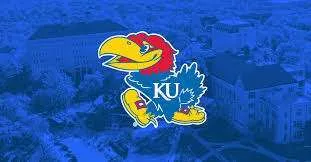From the Office of Public Affairs | http://www.news.ku.edu
Headlines
Insider trades on behalf of family are more lucrative than other trades, study finds
LAWRENCE — A new scholarly article from a University of Kansas professor of business compares the information content of direct insider trades made in a personal account versus indirect ones made in the accounts of family members, trusts, retirement accounts and foundations. The new research determines these trades contain more predictive information about earnings surprises and large price changes.
Geologic map for Miami County now available
LAWRENCE — The Kansas Geological Survey has released a new full-color geologic map of Miami County that highlights the type and age of rock layers found at the surface or immediately below the vegetation and soil in the county. The award-winning map provides important information about the distribution of limestones used to make aggregate for construction. Miami County’s limestone aggregate resources are increasingly important to support the transportation infrastructure needs in northeast Kansas.
Grants support increase in research-intensive courses at KU
LAWRENCE — In an effort to provide research opportunities to more students, 18 University of Kansas faculty members are working with the Center for Undergraduate Research this fall and spring to redesign portions of their courses to include a larger research or creative component. Recipients of the Research-Intensive Course Grants participate in a workshop to learn best practices, share models and refine the focus of their classes. Over 400 students were enrolled in the 2022 fall semester research-intensive courses through the program.
Full stories below.
————————————————————————
Contact: Jon Niccum, KU News Service, 785-864-7633, [email protected]
Insider trades on behalf of family are more lucrative than other trades, study finds
LAWRENCE — When people hear the term “insider trading,” they typically think of financial scandals involving Martha Stewart, Ivan Boesky or the movie “Wall Street.” But the term also has far less sinister connotations.
“Insiders trade in shares of their firms all the time,” said Jide Wintoki, Capitol Federal Professor of Finance and associate dean of graduate programs at the University of Kansas School of Business.
“But we identify a unique group of these trades made on behalf of other people who the insider may be connected to. It’s not in their own account; it’s on behalf of others. The evidence we present suggests these tend to be even more informed than the other insider trades.”
His article titled “Indirect Insider Trading” compares the information content of direct insider trades made in a personal account versus indirect ones made in the accounts of family members, trusts, retirement accounts and foundations. The research determines these trades contain more predictive information about earnings surprises and large price changes. It appears in the Journal of Financial and Quantitative Analysis.
A comparable analogy would be if a person wanted to place a bet on a horse race but had their spouse do it instead.
Wintoki, who co-wrote the paper with Bradley Goldie of Miami University, Chao Jiang of the University of South Carolina and Paul Koch of Iowa State University, notes that 18% of all trades are indirect insider ones. His team hand-collected data from files containing the individual Form 4s filed by insiders electronically, which are available on the Securities and Exchange Commission (SEC) website. The files indicate (in field No. 7) whether these are direct or indirect trades.
“Employees can do insider trades, too,” he said. “However, the reason why we have this data is that rank-and-file employees don’t have to tell the SEC, but executives, managers, the owners of the firm and directors of the firm have to do so.”
That’s the “how” part of this research. But “why” exactly do indirect trades outperform direct trades?
He said, “If you think about insider trading, they can be entirely for liquidity reasons. ‘I hold stock. But my daughter is getting married’ or ‘I need money to buy a boat.’ If you want to do that, you’re unlikely to be doing that in somebody else’s account. So if we want to narrow down which trades are most likely to be informed, there’s already one reason why you’re looking at this unusual set of trades. If you’re trading on behalf of somebody else, it’s unlikely to be unique personal liquidity.”
This isn’t necessarily done as a way of avoiding scrutiny by using someone else’s platform. Sometimes it’s as a convenient way to pass along wealth to a family member, for instance.
“If you buy shares in your own account and eventually sell the shares and give them the money, they would have to pay estate taxes,” he said. “Alternatively, if you have good news about the firm, you can just buy the shares in their own account. It’s theirs. And it’s not subject to gift taxes.”
Ultimately, the illegality of this is solely dependent on whether the watchdog agencies catch the individual who is doing it.
“Hypothetically, you can’t deliberately trade in the shares of your own firm using private information,” Wintoki said.
“When the DOJ or the SEC has enough information to indict you and prove that you deliberately and willingly traded on private information, that’s when they will take you to court for trading in your own stock.”
Wintoki spent a year as a visiting financial economist at the SEC, where he worked on securities enforcement against insider trading. He has been at KU since 2008, where he specializes in corporate and international finance.
“I’m still surprised how much more informed the indirect trades were,” Wintoki said of the key revelation in his research.
“The biggest lesson from this paper is that executives will find ways to make informed trades — and it turns out executives do that in their own accounts but even more so when they trade on behalf of other people.”
-30-
————————————————————————
The official university Twitter account has changed to @UnivOfKansas.
Refollow @KUNews for KU News Service stories, discoveries and experts.
Tweets by KUnews
————————————————————————
Contact: Julie Tollefson, Kansas Geological Survey, 785-864-2114, [email protected]
Geologic map for Miami County now available
LAWRENCE — The Kansas Geological Survey, based at the University of Kansas, has released a new full-color geologic map of Miami County that highlights the type and age of rock layers found at the surface or immediately below the vegetation and soil in the east-central Kansas county. Shaded relief provides a three-dimensional quality that accentuates the hills and valleys.
Rocks found at the surface in the county, an area of about 590 square miles, formed during the Pennsylvanian Subperiod (299-323 million years ago) when cycles of shallow seas, swamps and river channels deposited alternating beds of limestone, sandstone, shale and coal in eastern Kansas. The oldest rocks — the Hertha Limestone — crop out in river valleys in the southeastern part of the county. The youngest rocks — the Stanton Limestone — form the uplands in the northwest.
Miami County lies in the Osage Cuestas region of eastern Kansas, where gently dipping limestones and shales that underlie the entire county have been eroded to create ridges with steep, cliff-like faces on one side and gentle slopes on the other. Agriculture is important to the economy of Miami County, and the county is also home to Hillsdale Lake, a federal public water supply reservoir.
Mapped by KGS geologists Anthony Layzell, K. David Newell, Stephan Oborny, Rolfe Mandel and John Dunham, the new map provides important information about the distribution of limestones used to make aggregate for construction. In July, the map was recognized with an Excellence in Cartography award at the world’s largest conference dedicated to geographic information system (GIS) technology.
Aggregate materials are used to make concrete, mortar, asphalt and other similar products. Aggregate made from crushed stone is an essential component of the concrete and asphalt used to construct roads. Miami County’s limestone aggregate resources are increasingly important to support the transportation infrastructure needs in northeast Kansas, especially in the Kansas City metro about 25 miles north of the county.
The best Miami County limestones for aggregate production are found primarily in rock units that are part of the Upper Pennsylvanian Zarah Subgroup and include the Iola, Argentine, and Lower and Upper Farley limestones.
“The extensive exposures of near-surface Pennsylvanian limestone in Miami County are a major source of construction aggregate material needed to support urban growth in the Kansas City region and transportation infrastructure in the rest of the state,” said KGS geologist Jon J. Smith, principal investigator for the KGS STATEMAP geologic mapping project. “Paradoxically, this same growth threatens to envelop potential quarry sites, so it is very important that we identify the location and quality of limestone resources close to Kansas City before they are overtaken by urban sprawl.”
-30-
————————————————————————
Subscribe to KU Today, the campus newsletter,
for additional news about the University of Kansas.
http://www.news.ku.edu
————————————————————————
Contact: Matt Downen, Center for Undergraduate Research, [email protected], @ugresearchKU
Grants support increase in research-intensive courses at KU
LAWRENCE — In an effort to provide research opportunities to more students, 18 University of Kansas faculty members are working with the Center for Undergraduate Research this fall and spring to redesign portions of their courses to include a larger research or creative component. Recipients of the Research-Intensive Course Grants participate in a workshop to learn best practices, share models and refine the focus of their classes.
“These courses will provide many students with the opportunity to participate in research and creative scholarship across a wide range of disciplines,” said Alison Olcott, director of the Center for Undergraduate Research. “This academic year will have the most awardees since the Research-Intensive Course Grant program was created, illustrating the importance of providing students with opportunities to do research in class as well.”
Research-Intensive Course Grants are part of the overall efforts of the Center for Undergraduate Research to provide accessible research opportunities for KU students. The goal is to support faculty who are developing these types of courses so more students can be exposed to the high-impact practice of undergraduate research. Over 400 students were enrolled in the 2022 fall semester research-intensive courses.
This academic year’s recipients were from a variety of disciplines.
“Almost everything in strategic communication is based on research, as we need to understand how an audience feels about a product, service or idea, in order to effectively communicate our message,” said Joseph Erba, associate professor of journalism. “The Research-Intensive Course Grant allowed us to collect primary data via a social media analytics software that is widely used in our profession. Students got a ‘behind-the-scenes’ look at how these data are collected and used them to provide recommendations for a mock communication campaign they are working on.”
Jennifer Lohoefener, assistant research professor in electrical engineering & computer science, transformed her course this fall by incorporating research.
“The value of incorporating research into our Programming Languages course (EECS 662) is it’s brought a fresh perspective to language design that was lacking before,” Lohoefener said. “Students are encouraged to be curious and know that success is not always absent of failure. Sometimes success is failure. They’ve been given a chance to explore how today’s languages have come into existence and have developed a newfound appreciation for the scholars that have come before them.”
Fall 2022 recipients include the following faculty members:
1. Thom Allen, lecturer in architecture, Arch 177, Cities and Resources
2. Yvonnes Chen, professor of journalism & mass communications, JMC 420, Principles of Strategic Communication I
3. Joseph Erba, associate professor of journalism & mass communications, JMC 420, Principles of Strategic Communication II
4. Nisha Fernando, associate professor of interior architecture, IA 508, Interior Architecture Studio III
5. Jennifer Lohoefener, assistant research professor of electrical engineering & computer science, EECS 662, Programming Languages
6. Shuai Sun, assistant teaching professor of chemistry, CHEM 150, Chemistry for Engineers
Spring 2023 recipients include the following faculty members:
1. Rafael Acosta, associate professor of Spanish & Portuguese, SPAN 560, Not the World We Have but the One We Need (social film studies capstone)
2. Miguel Angel Albujar-Escuredo, lecturer in Spanish & Portuguese, SPAN 448, Language & Culture for Business
3. Joseph Erba, associate professor of journalism & mass communications, JMC 640, Strategic Campaigns
4. Eileen Hotze, associate teaching professor of molecular biosciences and undergraduate biology, BIOL507, Bacterial Infectious Disease Laboratory
5. Chien-Ho Ko, research professor of civil, environmental & architectural engineering, CMGT 712, Construction Safety Solution Development
6. Olga Kyrylova, visiting assistant professor of film & media studies, FMS 177, Ukraine Through the Lens of Film
7. Brian Lagotte, director of undergraduate programs, Center for Global & International Studies, GIST 698, Capstone Seminar
8. David Mai, assistant teaching professor of film & media studies, FMS 303, Intermediate Animation
9. Stephen Politzer-Ahles, associate teaching professor of linguistics, LING 435, Psycholinguistics
10. Kelly Sharron, lecturer in sociology and in women, gender & sexuality studies, SOC 450, Gender and Society
11. Judy Wu, lecturer in pharmacy practice, PHAR 535, Pharmacy Skills laboratory VI
12. Jack Zhang, assistant professor of political science, POLS/EALC 666, Political Economy of Asia.
-30-
————————————————————————
KU News Service
1450 Jayhawk Blvd.
Lawrence KS 66045
Phone: 785-864-3256
Fax: 785-864-3339
[email protected]
http://www.news.ku.edu
Erinn Barcomb-Peterson, director of news and media relations, [email protected]
Today’s News is a free service from the Office of Public Affairs





